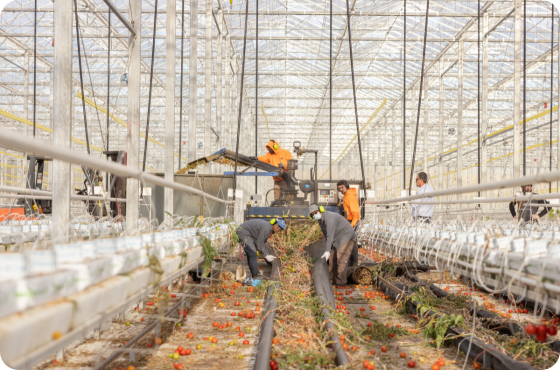Quality Products
Fast Delivery
Premium Service
Written by Martin Meuldijk | Last update: 9. August 2023
Crop rotation is a busy time: there's a short window to remove the old crop from the greenhouse and start the new cultivation promptly. That's why we've developed a detailed step-by-step plan for crop rotation. By carefully following each step in this checklist, you can ensure that no important tasks are overlooked.

Tomato hooks typically have an average delivery time of 10 weeks. To ensure timely delivery, it's advisable to place your order as early as possible. Determine the type of tomato hooks and twine you require, and calculate the number of boxes or pallets needed.
In October, most greenhouses are in the final stages of cultivation. The natural balance of beneficial crop predators is nearing its end. To prevent potential issues, it's crucial to thoroughly disinfect the old crop just before rotation. This prevents pests and disease from affecting the new crop. Often, broad-spectrum chemical crop protection products are used for disinfection.
Maintaining hygiene is essential when emptying the greenhouse. Prevent the spread of diseases and pests by ensuring careful disposal of crops. Consider local disease activity and handle crop removal accordingly to avoid future problems.
Once the workspace is empty, the cleaning process begins. Cleaning the greenhouse frame and equipment involves several phases. Use Removit to remove any chalk or coating residue from the glass. For general cleaning, water and possibly a glass cleaner suffice. Cleaning the greenhouse frame can start with clean water or specific products like TopCleaner or Flusol Forte, depending on the glass type.
Thoroughly clean your drip system, as a biofilm can develop within it, leading to the growth of algae, bacteria, molds, and viruses. Sediment and fertilizer reactions can also result in mineral deposits. Consider installing an ECA (Electro-Chemically Activated) unit to maintain clean water throughout cultivation. Menno ter Forte is recommended for cleaning algae growth outside the drip system.
After visual cleaning, clean the entire greenhouse. Use Menno Clean for cleaning. This powerful cleaner is known for its plant-friendly properties and quick effectiveness, making it ideal for regular cleaning of knives and scissors during harvesting. Additionally, Menno Clean is a versatile product that can be used to clean various items in the horticultural setting, such as greenhouse stand-ups, growing tables, containers, carts, jars, and machinery.
Ensuring a hygienic and clean greenhouse setup for your new crop is essential. Begin by placing films and cultivation substrate. Start with clean materials to prevent the transmission of diseases and pests. Also, disinfect tools like scissors and film clippers. Pay meticulous attention to hygiene for a successful start.
Prioritize personal hygiene for your employees. Diseases and pests often spread through hands and shoes. Depending on your crop and disease prevalence, implement personal hygiene measures such as cleaning shoe soles using Flexxolutions mats, providing guest jackets, using guest overshoes, and hand cleaning. For more complex hygiene requirements, Royal Brinkman offers comprehensive hygiene stations.
At the beginning of the clean cultivation cycle, when the new crop is planted, initiate the placement of biological pest/disease controls and start disease and pest monitoring. Begin by hanging sticky sheets or rolls, such as Biosignal sheets and rolls, for timely disease and pest detection. This also marks the commencement of weekly scouting, a foundation for effective crop protection.